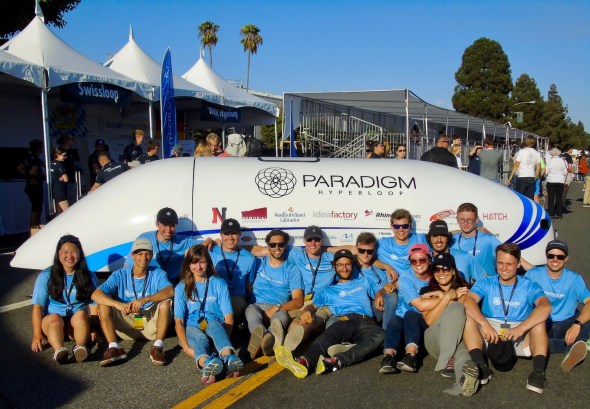Student team zooms past challengers in Hyperloop competition

After two years of work punctuated by “many sleepless nights,” Northeastern’s student team zipped into second place of the SpaceX Hyperloop Pod Competition, held on Sunday in Hawthorne, California.
The event, which included teams from around the globe, was the culmination of two previous competitions for Paradigm Hyperloop, the team comprised of students from Northeastern, Memorial University of Newfoundland, and the College of the North Atlantic. The first event, held about a year ago, checked teams for safety and design. The first competition was held at the end of January and allowed teams to test their prototypes at the SpaceX test track, earning awards for design and innovation. The competition on Sunday had only one criterion: speed.
Paradigm’s pod reached 63 miles per hour, topping the third place team Swissloop’s 25 mph. The winning team, WARR Hyperloop, clocked in at 200 mph.
Paradigm was one of just 24 teams selected to compete from an initial pool of more than 1,200 designs. Elon Musk, the founder of rocket and spacecraft manufacturing company SpaceX, started the competition in 2015 as a call for bright minds to make his Hyperloop idea a reality.

The Paradigm Hyperloop team poses with their pod. They plan to revise their design, making the pod smaller and faster. Photo courtesy of Luke Merkl.
The ultimate goal is a new mode of transport. Musk envisions a tube infrastructure connecting major cities, with pods carrying people and cargo traveling upwards of 700 mph. A ride from Vancouver to Los Angeles would take less than two hours. To go from Toronto to Manhattan would take 30 minutes.
Musk was watching from the sidelines along with students as their pods raced to make the fastest time. “He’s kind of a quirky dude and he’s absolutely brilliant,” said Luke Merkl, a fifth- year electrical engineering student at Northeastern who was part of the Paradigm Hyperloop team.
Merkl explained that Paradigm’s big innovation—and what set the team apart from every other team—was air levitation. Their system created a cushion of air for the pod to float on, “like an upside down air hockey table,” Merkl said. This drastically reduces friction and requires less energy than magnetic levitation, a method several teams employed.
The ease at which Paradigm’s 2,000-pound capsule glided through the track is miraculous, considering all the team overcame to get there. With more than 40 people from two different countries contributing to the project, collaboration was tricky but essential. The team communicated mostly through Slack and Google Hangouts, but also organized several working weekends where students from Canada flew to Boston. This allowed the two groups to combine components of the system they had designed separately.
The team also secured more than $150,000 in private funding, which included cash, in-kind donations, gift cards, and government grants.
“We like to call ourselves scrappy,” Merkl said.
And Paradigm is not ready to give up. There are plans for a third competition, although details haven’t yet been set. The team is already thinking about how to refine its design by chopping the size of its current pod so it’s lighter and faster.
“It was the largest and heaviest vehicle and we still managed to get second place,” said team member Theodore Rausch, a third-year engineering student at Northeastern. “If we had a smaller vehicle, I think we would have done even better.”





